DUSTPAN AND BUSH PART ONE
Alun Davies is riding in Namibia, Southern Africa, a country with over 36,600 miles of gravel and unpaved trails – and some pretty big wildlife, too…
The desert elephants of Namibia are known for being the Victor Meldrews of big tuskers. Having adapted to living in the harsh conditions of the sand dunes, arid mountains and hot gravel plains of Namibia, they tend to get overly cranky when their precious environment is threatened. And while they’re not a sub species of their Savannah-dwelling cousins, evolution has provided them with a larger foot base and proportionately longer legs, to aid crossing miles of sand at a rapid pace in search of scarce food and water.
It was the lankiness of their anatomy, or to be more precise, the gap between their bellies and the ground, which I’d just begun to contemplate with eyebulging alarm. And this is why: if you ever find yourself riding at 80mph on a loose gravel road with a back brake that’s failed twice in the last 24 hours, then it’s probably best not to check out the quality of the overnight repair when faced with a huge bull elephant stood smack-bang in the middle of the track a few hundred yards ahead.
At the start of our 2,000-mile motorcycle adventure on the gravel roads of Namibia, Ralf, our German guide, had told us that spotting one of these rare Namibian desert elephants would be a very lucky event. Indeed, I could recall watching a BBC TV documentary a few years back where viewers were led to believe that the crew had spent week upon torrid week in the desert and were on the verge of eating each other before coming across their first giant Namibian tusker.
As luck would have it, we’d spotted about 20 desert elephants over the past couple of days and all from a safe distance; Ralf reckoned it less that healthy to be closer than 500m. However, right now, even if the brake worked, I was on course for an extremely lucky event, maybe even lucky enough for my fellow travellers to be able to measure the abnormal size of the foot indent on my crushed torso. Under the circumstances, it was only mildly comforting to think that my last act on a motorcycle may be of interest to natural science.
Anyway, I’ll return to what it’s like to begin a death-slide on an XT 660 R into the world’s largest living land animal later, but for now, let’s wind the clock back to where it all began, sipping cold midmorning drinks at Ralf’s Mountain Lodge in the hills, just south of Windhoek, the capital of Namibia.
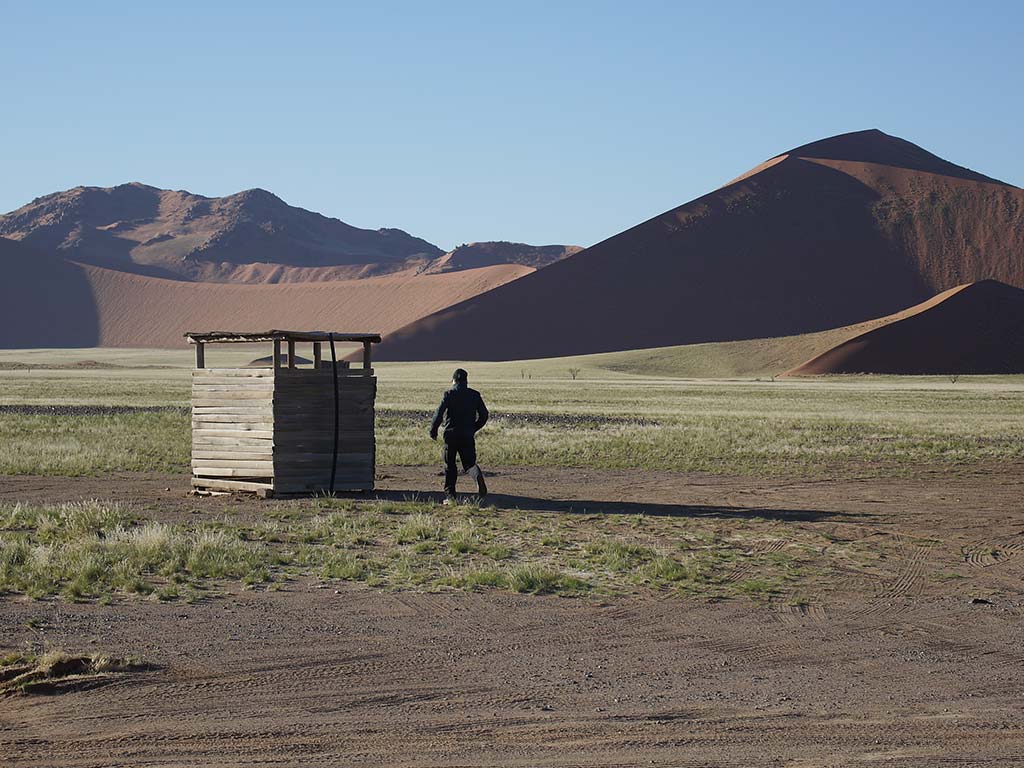
Are You Sitting Comfortably?
There were 12 of us in total; 11 German bikers and yours truly. We’d just flown in from Frankfurt and were now being briefed on what we could expect over the next 14 days. We’d kick off riding southeast to view the huge, world-famous sand dunes at Sossusviei before turning north and crossing the Namib Desert to the historic coastal towns of Walvis Bay and Swakopmund. From there we’d continue north along the Salt Road of the Skeleton Coast before heading east and inland to skirt Mt Brandberg (at 2,606m it’s the highest mountain in Namibia) and cross the surreal, parched, flat-topped tableland landscape of the Damaraland (think Monument Valley in the USA). We’d continue north into Himba country near the Angolan border before making an about turn back through Damaraland to the west of Etosha and finally into the central highlands and a return to Windhoek. A total of approximately 2,000 miles with all but a few of them spent riding on gravel and sand.
Ralf, who’s been leading and organizing trips in Namibia for the last 20 years, was at pains to warn us of the dangers of riding in the country, which in addition to common and garden off-road motorcycle mishaps could include; nil visibility in dust and sandstorms, wild and domestic animals throwing themselves on the trail, unexpected areas of soft sand, snakes and other things that bite, kamikaze piste-grading machinery drivers, mini tornadoes, flash floods, no warnings of washed-out trails, dehydration, sun stroke, and alien abduction. Keen and knowledgeable readers will of course realise that I’ve just made up one of those threats; the fact is, piste-grading drivers are exceptionally courteous.
There was also the constant threat that comes with the remoteness in this part of Africa, and the lack of medical aid on hand should you end up on your arse holding a severed foot in your hand. That said, it was also emphasized that this was no technical off-road enduro, nor a race, and would be within the capabilities of all riders once they’d found their ‘gravel legs’.
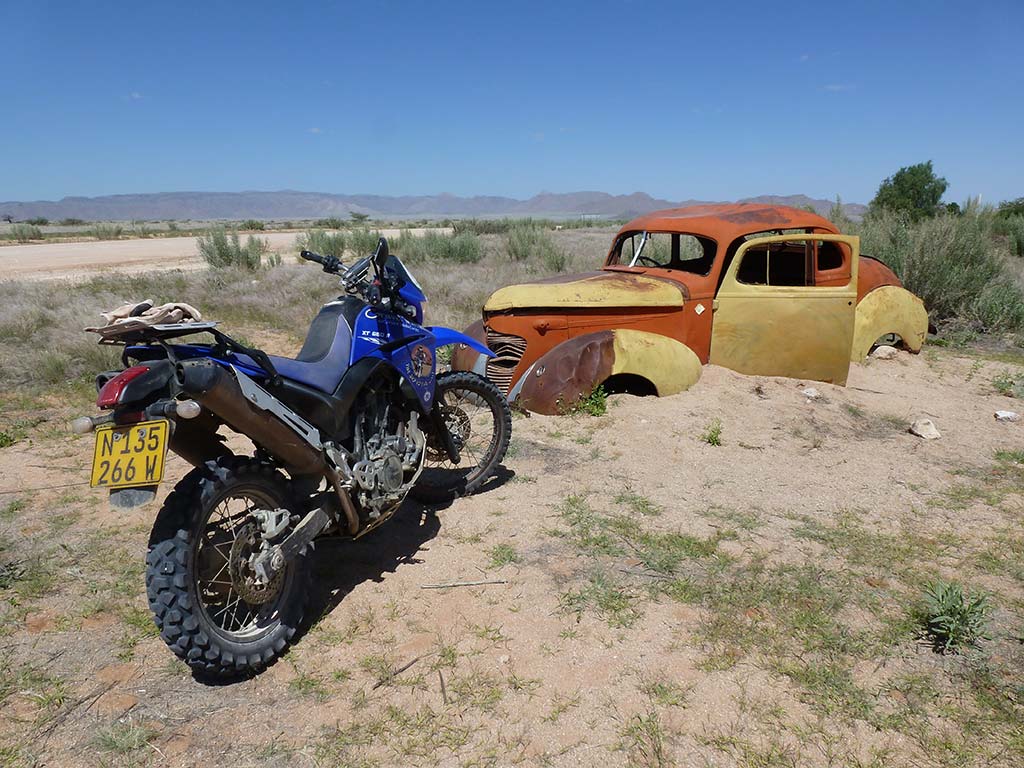
Follow The Leader
And so to the first afternoon, which was a 50-mile trial run from Mountain Lodge on gravel and sand, to help the first timers get a handle on riding off-road, or should I say, off-tarmac. We’d also be following a route on our individual bike-mounted GPSs, with Ralf bringing up the rear in a support truck complete with first-aid equipment, spares, fuel, our personal gear, and a replacement bike – just as we’d be doing for the next 14 days. The advantage of having a personal GPS was that it allowed us to travel at our own pace following a pre-programmed route, something that was appreciated by all throughout the trip. If you wanted to buddy up, there was always someone to ride with, but if you wanted to have some quiet time riding alone or raise the pace to scary Dakar levels, then the choice was all yours.
The trial run was a gentle affair but an eye-opener for those who’d never before rolled rubber on ground that moves. The trail contained soft, sandy stretches and water splashes but was mostly of ball-bearing sized gravel covered in dust. There was also the odd herd of cows to contend with, plus a troop of baboons, and the ever-present blinding dust thrown up by approaching 4X4s. By the time we returned to the lodge there’d been a couple of minor o‑s and a few worried looks of the type that said, ‘if that was 50 miles, how the hell am I going to complete 2,000!?’
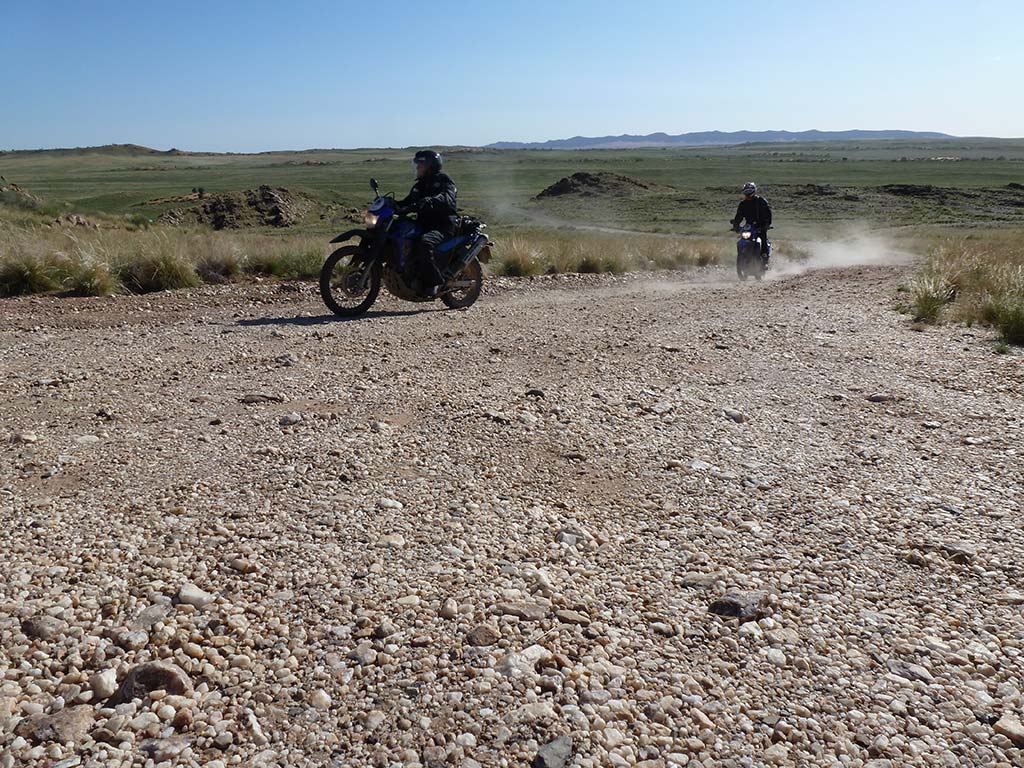
Big Country
The next morning, we were up early and on the piste heading to the mammoth sand dunes at Sossusviei, a trip of about 200 miles in total across the high central plateau of Namibia, before dropping down into the Namib Desert.
From the off it was plain to see that we’d be having plenty of wilderness moments, with a land mass three—and-a half times the size of the UK and with a thirtieth of its population – a fifth of which lives in Windhoek – there was, well, err, lots and lots of nothing. It’s extremely fortunate that I have a long history of likin nothing.
To contextualize the scale and remoteness of Namibia a little more, many ABR readers will have been to Morocco or at least thought about riding there and will therefore have some idea of the scale of the huge wilderness areas in the north African country. Well, Namibia is over twice the size of Morocco with just one fifteenth of its population, and whereas the famous Saharan dunes at Erg Chebbi rise to 150m in height and stretch for 13 miles north to south, the dunes of the Namib Desert are over 380m high and run for roughly 750 miles north to south. Namibia is like Morocco on wilderness steroids; only Mongolia and Greenland have lower population densities when measured by the number of humans per square kilometer.
The first 120 miles took us over the Khomas Hochland region, the high central plateau of Namibia. The trails followed ridge lines with huge views and endless African skies. We sped across rocky plains and through dry river beds, very occasionally passing by the odd small settlement. The trail conditions were generally good, allowing a fast pace for those who felt up to it, though it was all too easy to have a moment when hitting a patch of soft sand or four-inch deep section of ultra-fine gravel and dust.
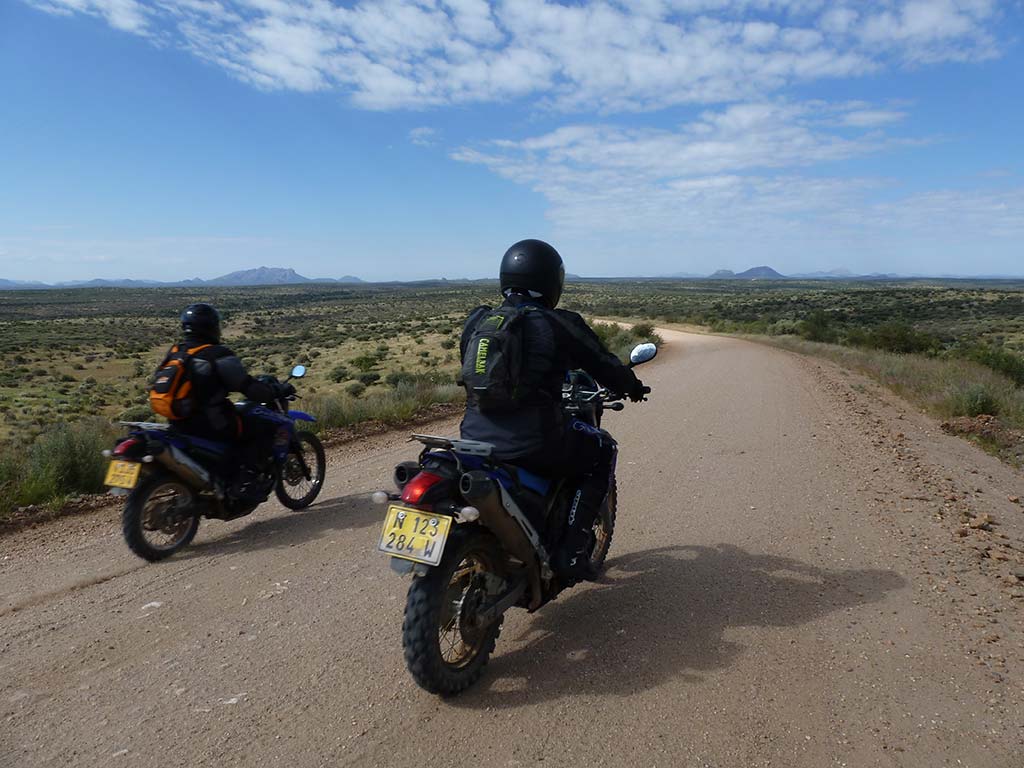
Riddle Me This
By the time we’d dropped down from the highlands and into the Namib Desert to rendezvous at the remote outpost of Solitaire there were a couple of things that came to mind. Apart from the dramatic scenery, it didn’t feel like we were in Africa, or even a desert for that matter. For a start, the very few people we’d seen over the previous 120 miles had all been white and driving big, expensive 4X4s, plus, if this was the infamously arid Namib Desert, why was there so much grass and vegetation?
The fact that very few people live in the region was the answer to the prevalence of 4X4s, which were all heading to the tourist honeypot of Sossusviei, and the reason for all the vegetation was that we were riding a week after Namibia had experienced the biggest rains in 20 years. We were constantly told that we were so lucky to see the desert in bloom and the last time it had looked remotely like this was seven years previous: in normal times, there is no vegetation at all.
Solitaire is a bit of an oddity comprising a petrol station, café, and – this is the really odd one – a bakery selling fantastic apple pies and run by a guy who’s become a legend in his own lifetime. Moose McGregor’s Desert Bakery, which must be the most remote bakery in the world, has become as much of a draw as the huge dunes 50 miles further down the road. It’s also become a pilgrimage site for ABRs riding through Namibia, including Ewan and Charley, who popped in for a slice of apple pie while filming the Long Way Down.
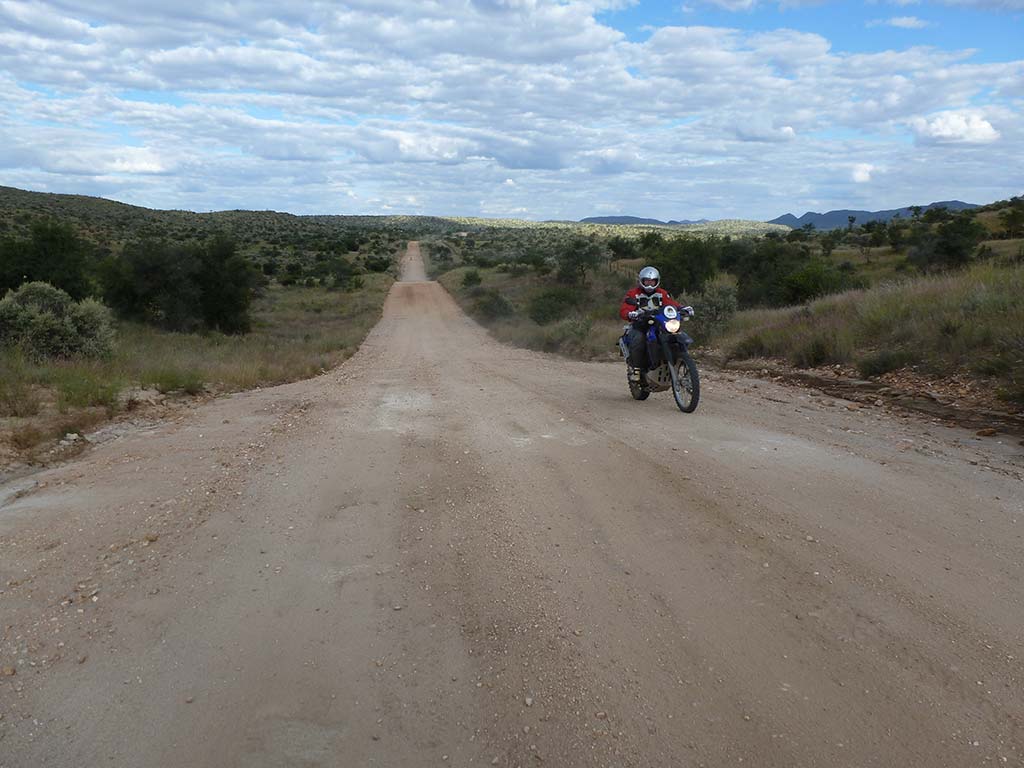
Wilderness Is Paradise Now
Our first night in the wilderness was spent under the finest Egyptian cotton at Sossusviei Lodge, a remarkably luxurious hotel near the gates of the Sossusviei National Park. Hardcore, eh? Having spent the day riding through terrain untouched by humans we were now in the lap of luxury, complete with swimming pool, choice of restaurant, individual air-conditioned chalets and a couple of well-stocked bars.
With apologies to the great Omar Khyam, ‘Oh wilderness is paradise now’.
As bikes are not allowed in the national park, we climbed aboard a truck before sunrise the next morning to go and view the remarkable spectacle known as Sossusviei. The park is essentially a 30-mile-long dead-end valley where instead of granite or limestone mountains forming the side ridges there are massive 380m high sand dunes. Occasionally, say once every 10 years, during periods of heavy rain, the river on the valley floor flows and the ground comes alive with vegetation and flowers and the ‘pan’ at the head of the valley woods. It truly is a surreal work of art by Mother Nature, and we were lucky enough to experience Sossusviei in all its blooming glory.
By mid-afternoon we were back in our riding gear and astride our bikes, heading north to Rostock Ridge, a place in the middle of the centre of nowhere. There we’d overnight and prepare for a full crossing of the Namib Desert and on to the Skeleton Coast.
As for my confrontation with the desert elephant, I’m afraid you’re going to have to wait until the next issue. Oh, and by the way, I’ll also let you know what it’s like to race a leopard on an XT.
Alun went to Namibia with Gravel Travel and did the 14-day Namibia Tour Special. For more information and bookings, see www.motorcycle-travel-africa.com
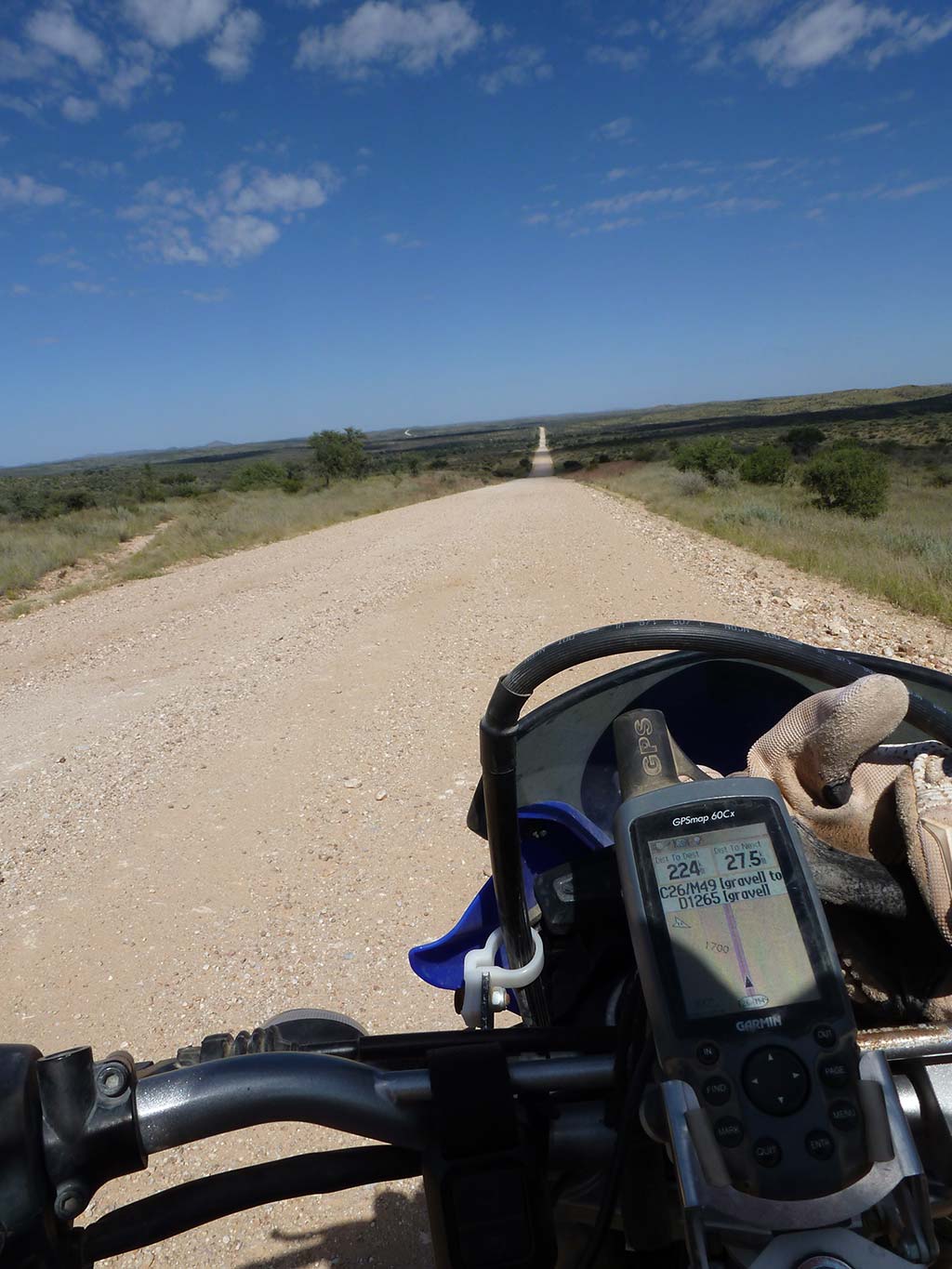
Who’s The Daddy?
Tourist board PR companies all issue frenzied press releases when it comes to claiming to host to the largest sand dunes in the world, and Namibia is one such example. There’s no denying that the huge piles of grain at Sossusviei are a spectacular and phenomenal sight, and at 380m high they are certainly massive, but having consulted my personal dune guru the following seems to be the case: the highest plies of sand in the world are the Cerro Blanco dunes in Peru, which top out at 1,176m. Second are the Badain Jaran dunes in the Gobi Desert at 500m, followed by Big Daddy, the highest dune at Sossusviei.
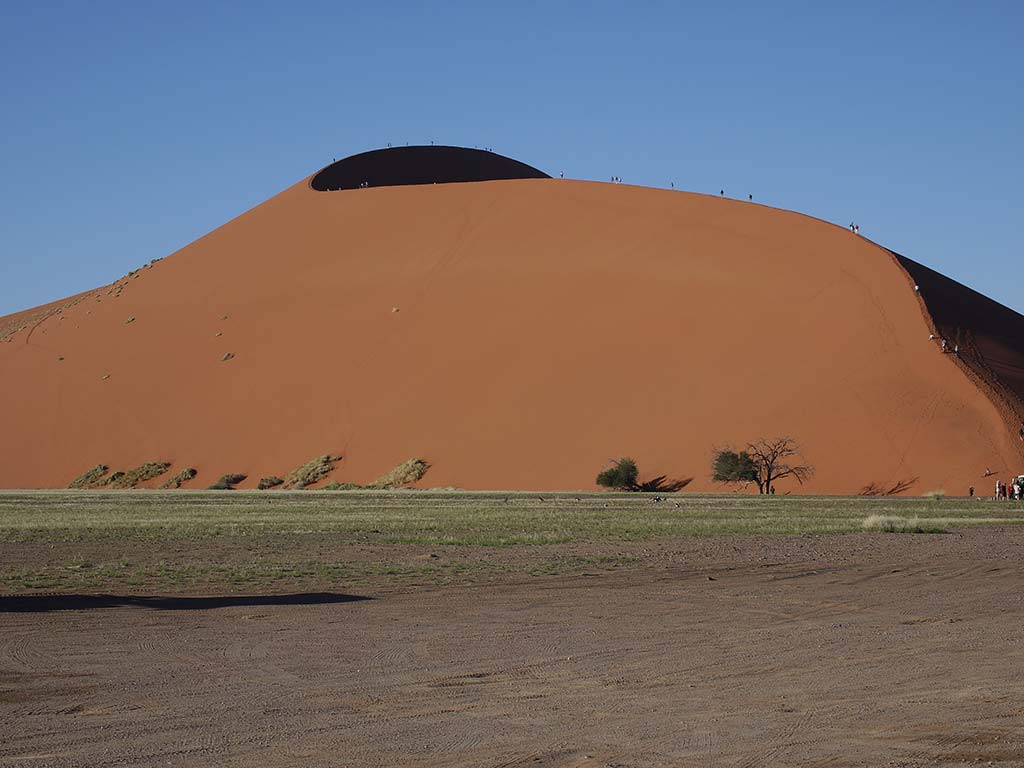
The Gravel Roads Of Namibia
For a country that’s over three times the size of the UK, Namibia has only 3,100 miles of paved roads. On the plus side, assuming you like off-road riding, it has some 36,660 miles of gravel and unpaved trails. Namibia is an ABR Nirvana; it’s like riding Enduro through a zoo.
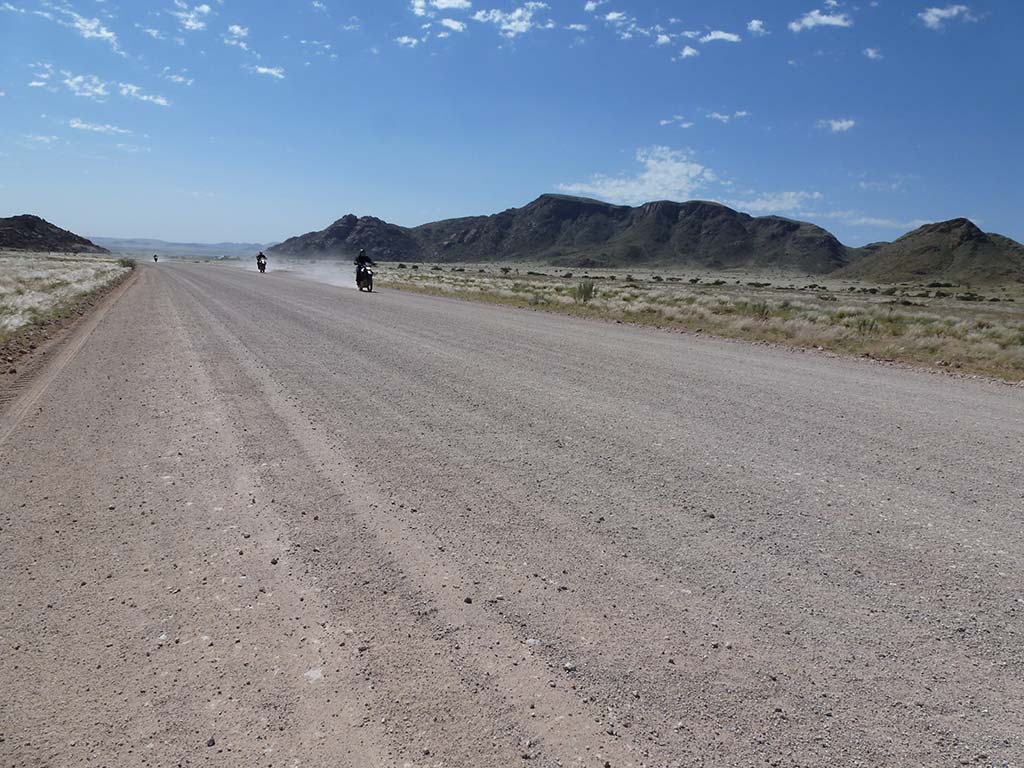
The Bikes
Ralf’s motorcycle business in Namibia, Gravel Travel, has around 70 motorcycles split between XT 660 Rs and XT 660 Zs. He also owns a Yamaha motorcycle dealership in Germany through which he imports the machines to Namibia. By way of background, Ralf has been offering motorcycle tours in Namibia for 20 years and he’s a veteran desert rally rider. A man who obviously knows his stuff, so why does he recommend the R rather than the Z? According to Ralf, it’s a combination of weight (the R is 30kgs lighter) the ergonomics of the bikes (he reckons the stubbier R is better suited to sand and gravel) the lower centre of gravity and the seat height. Basically, Ralf feels that the R is the safer version for inexperienced riders, but when asked which one he would choose, he says he’d still go for the R every time. Back home in the UK, I own a Z, and if pushed, would say it’s close to, if not the best all-round adventure bike in current production. However, I also reckon that a beefed-up R is probably better suited to the Namibian terrain, but only if you have a supply truck backing you up with fuel and carrying your personal gear. For full-on unsupported touring, I’d go with the XT 660 Z In summary, I was massively impressed with the ability and robustness of the XT 660 R, a bike I’ll admit to overlooking in the past.
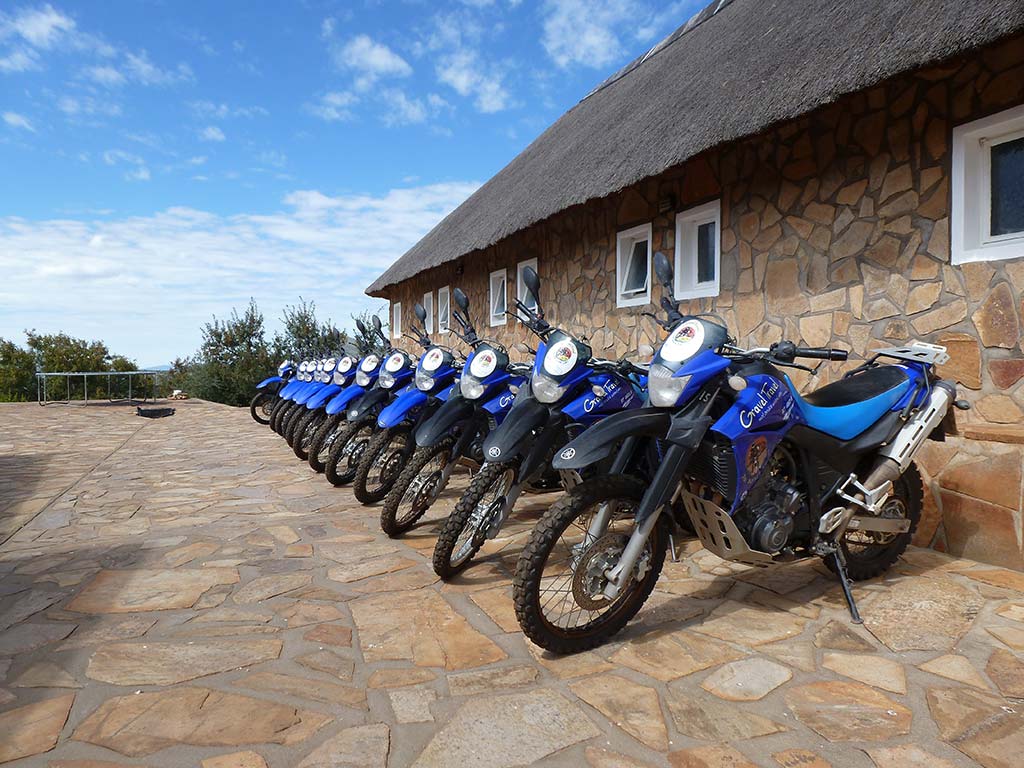
WANT TO DO THIS?
- How long does it take? Ralf’s company Gravel Travel offers a number of different trips in Namibia and South Africa, all of which take a couple of weeks to complete. The trip I’ve been writing about here is the Namibia Tour Special, a 14-day fully supported tour covering 2,000 miles of gravel trails around the highlights of Namibia For more, see motorcycle-travel-africa.com.
- How much does it cost? The all-inclusive package, which also includes flights, costs €4,340 (around £3,464). The only extra you’ll need to pay is the bar bill.
- When to go? As Namibia’s in the southern hemisphere, it’s summer there during the UK’s winter. There’s nothing to stop you touring through Namibia at any time of year, though Ralf’s company Gravel Travel tends to run tours between November and April.
- Get there: Air Namibia flies from Frankfurt direct to Windhoek, the capital of Namibia. The best alternative to a direct flight is to fly in to a main South African airport with a connection to Windhoek.
- Solo or with a group? There are pros and cons for both independent travel and joining up with a group, but if you’ve only got a couple of weeks to spare then signing up to an organized tour with full back-up will ensure you see as much of the country as possible in the time allowed with the minimum of hassle. It’ll also allow you to travel to places which you’d not be able to reach without remote fuel dumps. Plus, there are no guarantees that the fuel stops in Namibia will have fuel. We turned up at one petrol station 120 miles from the next and they were dry; the next expected delivery was in three days’ time. Fortunately, we had a back-up truck carrying fuel.
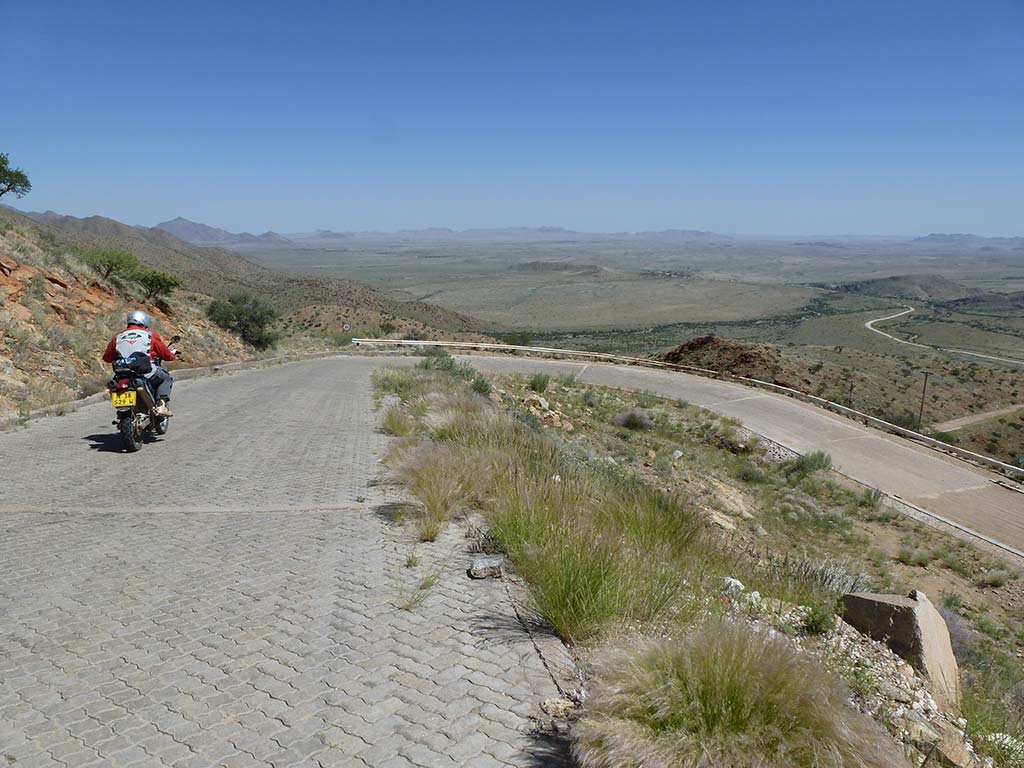
- Accommodation: Even in the most remote areas of Namibia you’ll find a wilderness or mountain lodge at a standard that’ll blow you away. And they’re not that expensive either. It is possible to camp just about wherever you want in Namibia, but just remember there’s a lot of wildlife roaming freely in the country (including elephants, lions, leopards etc.) and unless you’re sticking to the main tarmac roads, it may be worthwhile camping in a designated campsite for security.
- Paperwork for you: My driving licence was never checked, though it’s probably best to pack both a UK and International licence, to cover all eventualities. You can pick up an entry Visa at the point of entry with no fuss.
- Is it for you? The thought of riding 2,000 miles on gravel and sand trails around Namibia would probably frighten off most riders without any off-road experience. However, having been on a trip where 50 percent of my fellow riders had never been off-road, I can categorically say that, if you can ride a bike and you want an adventure in Namibia, do not let your inexperience put you off. There is nothing that technical about riding on gravel and sand that you can’t pick up in a day or two, providing you ride at a pace at which you feel comfortable.
Pack Your Panniers!
ABR Mike Stevens, retail director of Cotswold Outdoor, has a BMW R 1200 GS; here are his Namibian lodge safari essentials
When traveling between lodges in Sub-Saharan Africa, you’re free to leave your camping gear behind and enjoy the fabulous locations and scenery in luxury. However, good kit can still make a huge difference to your trip. The hot, dry and dusty conditions in Namibia mean you’ll need to be prepared for some tough, exhilarating riding during the day while still making the most of the comforts and surroundings at night. This kit list has a few suggestions to help you achieve that:
- Sunglasses: Julbo Reflex, £75
Whether riding dusty trails in the sun all day or kicking back outside the lodge watching the sun set, these glasses will do the job. With interchangeable lenses to suit all conditions and total-wrap geometry, these glasses provide complete protection from the deserts sun’s glare while still looking cool.
- Hydration: Camelbak M.U.L.E. ,£80
Staying hydrated is key to any successful Africa trip. Poor concentration, fatigue and headaches are all classic symptoms of even the slightest dehydration. This pack from Camelbak holds a massive 3 litres of fluid, incorporates Camelbak’s proven systems and has a useful 9.5 litres of luggage space. Its ventilated back panel and slim profile make it ideal for use on long days on the bike.
- Dust protection: Aqua Pack Cases, from £16
Namibian dust gets everywhere and if it gets inside your camera or phone (which it will), it could prove disastrous. Investing in a dust-proof case is a must for all electronic items. Small, light and flexible, these Aqua Pack cases are ideal for protecting your kit from the elements. Put each of your electronic gadgets in to one of these and throw them in your M.U.L.E.
- Clothing: Craghoppers Nosilife Shirt, £50
A superb shirt for hot-weather travel with built-in mosquito protection, an SPF of 40+, mesh vents and antibacterial treatment, it’s just about the perfect top for this trip. Match this with a pair of Kiwi Zip-off Trousers (£45) that convert into shorts and you’re all set for an evening meal or moonlight trek. To stop the sun getting to your head and neck, and the dust from getting up your nose, you’ll need a UV-protective Buff (£14). Wear it as a beanie or a bandana.
- Skincare: Lifesystems range, from £5.75
Not traditionally an ABR’s first thought, but Mosquitos and sun damage can be a big issue in Namibia, so make sure you take a good repellent. Lifesystems Expedition range (from £5.75) is among the best but check out what strength is right for you in a local store or online. Sun cream is essential in this climate. Lifesystems products (from £8.50) are specifically designed for use in the harshest environments.
- Hat: Tilly, from £59
Possibly not the cheapest but probably the best travel hat in the world ever with a UPF of 50+, good ventilation, a wide brim and a lifetime guarantee. Trips like this are what Tillys are made for.
- Luxury item: Barska 8*21 binocular, £30
Enhance your trip with these handy lightweight binoculars. Watch the wildlife from afar or check out the next distant horizon.
Photos: Alun Davies



